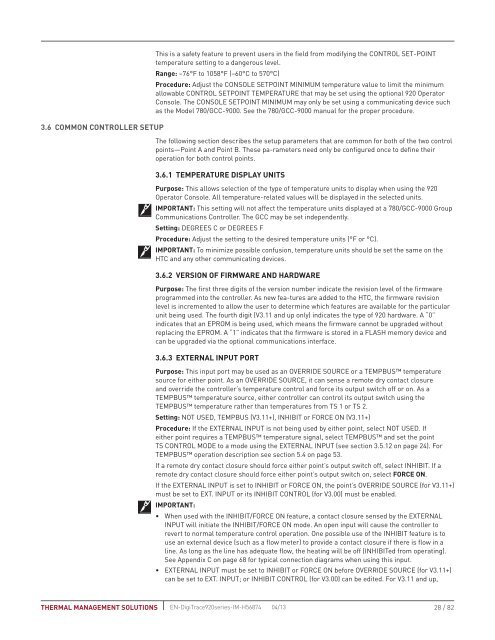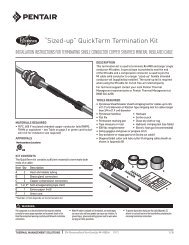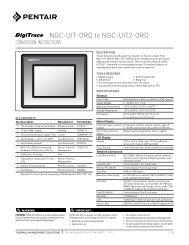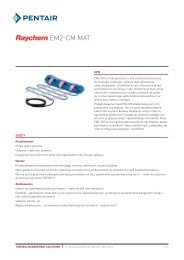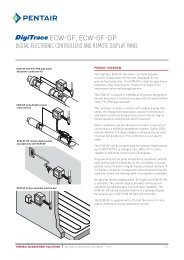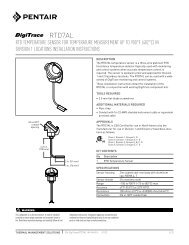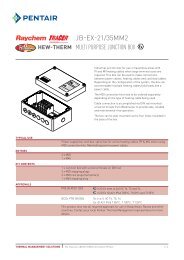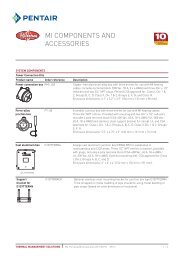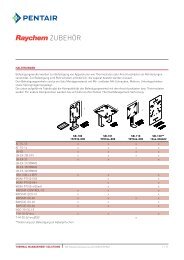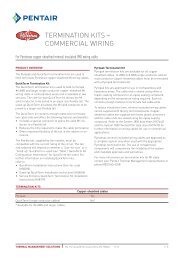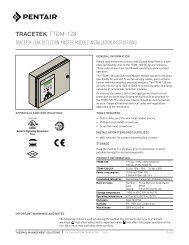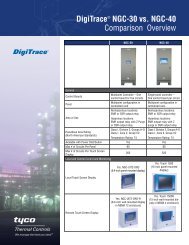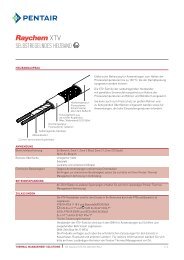DigiTrace 920 Series Heat Trace Controller - Pentair Thermal ...
DigiTrace 920 Series Heat Trace Controller - Pentair Thermal ...
DigiTrace 920 Series Heat Trace Controller - Pentair Thermal ...
Create successful ePaper yourself
Turn your PDF publications into a flip-book with our unique Google optimized e-Paper software.
3.6 Common <strong>Controller</strong> SetupThis is a safety feature to prevent users in the field from modifying the CONTROL SET-POINTtemperature setting to a dangerous level.Range: –76°F to 1058°F (–60°C to 570°C)Procedure: Adjust the CONSOLE SETPOINT MINIMUM temperature value to limit the minimumallowable CONTROL SETPOINT TEMPERATURE that may be set using the optional <strong>920</strong> OperatorConsole. The CONSOLE SETPOINT MINIMUM may only be set using a communicating device suchas the Model 780/GCC-9000. See the 780/GCC-9000 manual for the proper procedure.The following section describes the setup parameters that are common for both of the two controlpoints—Point A and Point B. These pa-rameters need only be configured once to define theiroperation for both control points.3.6.1 TEMPERATURE DISPLAY UNITSPurpose: This allows selection of the type of temperature units to display when using the <strong>920</strong>Operator Console. All temperature-related values will be displayed in the selected units.IMPORTANT: This setting will not affect the temperature units displayed at a 780/GCC-9000 GroupCommunications <strong>Controller</strong>. The GCC may be set independently.Setting: DEGREES C or DEGREES FProcedure: Adjust the setting to the desired temperature units (°F or °C).IMPORTANT: To minimize possible confusion, temperature units should be set the same on theHTC and any other communicating devices.3.6.2 VERSION OF FIRMWARE AND HARDWAREPurpose: The first three digits of the version number indicate the revision level of the firmwareprogrammed into the controller. As new fea-tures are added to the HTC, the firmware revisionlevel is incremented to allow the user to determine which features are available for the particularunit being used. The fourth digit (V3.11 and up only) indicates the type of <strong>920</strong> hardware. A “0”indicates that an EPROM is being used, which means the firmware cannot be upgraded withoutreplacing the EPROM. A “1” indicates that the firmware is stored in a FLASH memory device andcan be upgraded via the optional communications interface.3.6.3 EXTERNAL INPUT PORTPurpose: This input port may be used as an OVERRIDE SOURCE or a TEMPBUS temperaturesource for either point. As an OVERRIDE SOURCE, it can sense a remote dry contact closureand override the controller’s temperature control and force its output switch off or on. As aTEMPBUS temperature source, either controller can control its output switch using theTEMPBUS temperature rather than temperatures from TS 1 or TS 2.Setting: NOT USED, TEMPBUS (V3.11+), INHIBIT or FORCE ON (V3.11+)Procedure: If the EXTERNAL INPUT is not being used by either point, select NOT USED. Ifeither point requires a TEMPBUS temperature signal, select TEMPBUS and set the pointTS CONTROL MODE to a mode using the EXTERNAL INPUT (see section 3.5.12 on page 24). ForTEMPBUS operation description see section 5.4 on page 53.If a remote dry contact closure should force either point’s output switch off, select INHIBIT. If aremote dry contact closure should force either point’s output switch on, select FORCE ON.If the EXTERNAL INPUT is set to INHIBIT or FORCE ON, the point’s OVERRIDE SOURCE (for V3.11+)must be set to EXT. INPUT or its INHIBIT CONTROL (for V3.00) must be enabled.IMPORTANT:• When used with the INHIBIT/FORCE ON feature, a contact closure sensed by the EXTERNALINPUT will initiate the INHIBIT/FORCE ON mode. An open input will cause the controller torevert to normal temperature control operation. One possible use of the INHIBIT feature is touse an external device (such as a flow meter) to provide a contact closure if there is flow in aline. As long as the line has adequate flow, the heating will be off (INHIBITed from operating).See Appendix C on page 68 for typical connection diagrams when using this input.• EXTERNAL INPUT must be set to INHIBIT or FORCE ON before OVERRIDE SOURCE (for V3.11+)can be set to EXT. INPUT; or INHIBIT CONTROL (for V3.00) can be edited. For V3.11 and up,THERMAL MANAGEMENT SOLUTIONS EN-<strong>Digi<strong>Trace</strong></strong><strong>920</strong>series-IM-H56874 04/13 28 / 82


